Longboard surfboards have a special place in the heart of many surfers and the history of surfing as a whole. Longboard surfboards are easy to learn on and fun to use in a variety of conditions. In fact, most surfers prefer to have a longboard in their quiver regardless of their skill level.
This article includes helpful information about longboard surfboards and will point you in the right direction if you are looking to buy a longboard. Continue reading to find the right longboard surfboard for you!
A longboard for every type of surfer
Best overall longboard for beginners – 8’ Verve South Beach Board Co.
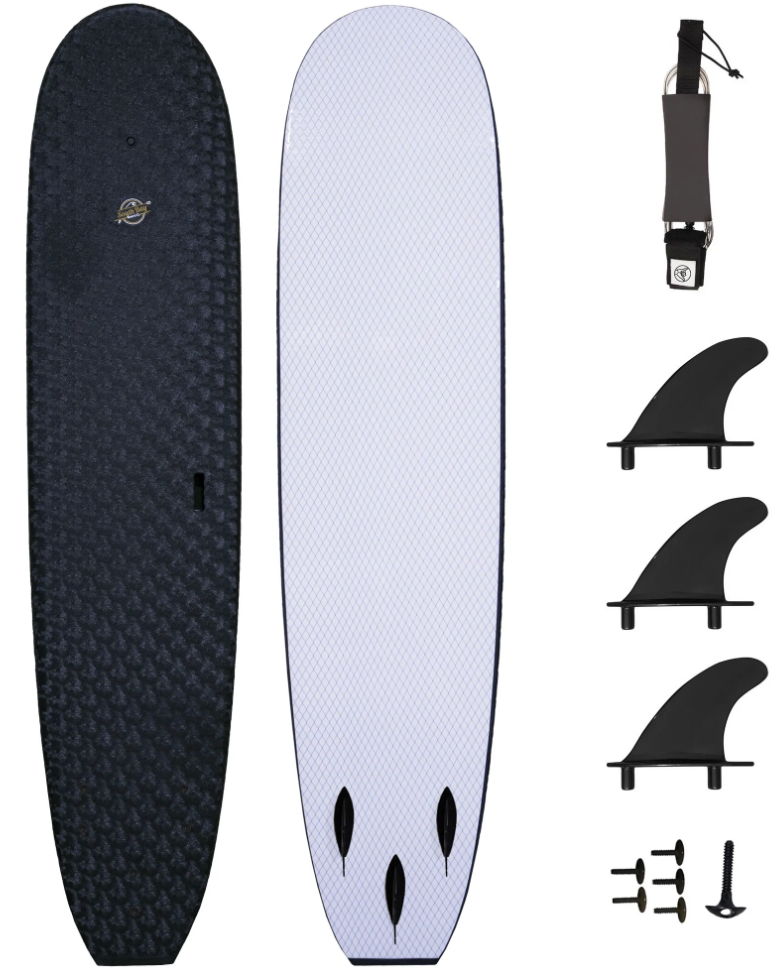
Beginner friendly shape also suitable for learning turns. An all-around quality soft-top you can grow with.
Best budget longboard – Wavestorm
Probably most affordable soft-top you can buy. Best option to test out surfing and minimize high cost.
Best longboard for kids learning to surf – 7’6” TAHE Paint Easy
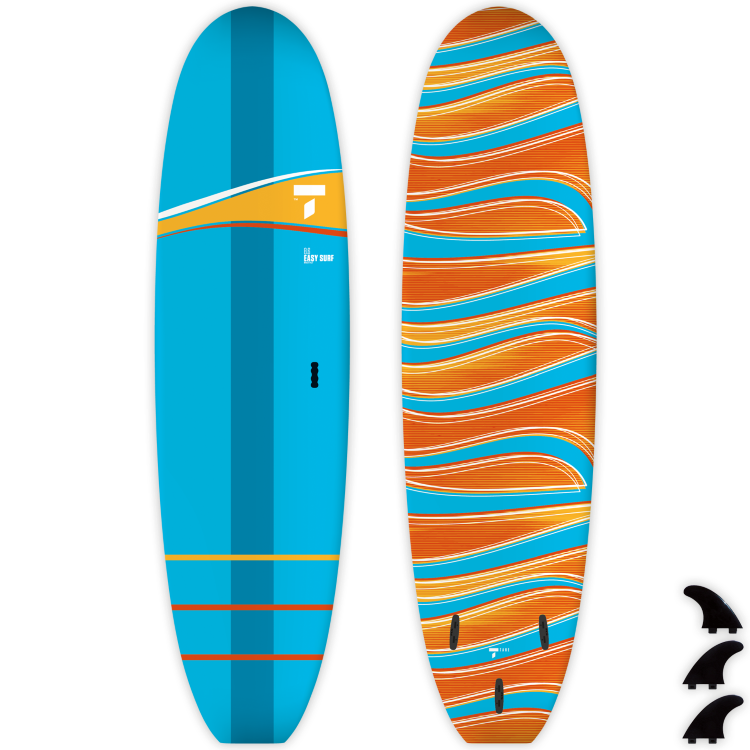
High volume, wide, stable, and super buoyant. Best for true beginners, especially lighter surfers and kids.
Best epoxy longboard – 10’ Degree 33 Surfboard
All around solid multi-condition longboard. Durable hard-top suitable for beginner to advanced.
Best mini longboard – 7’6” TAHE Mini Longboard
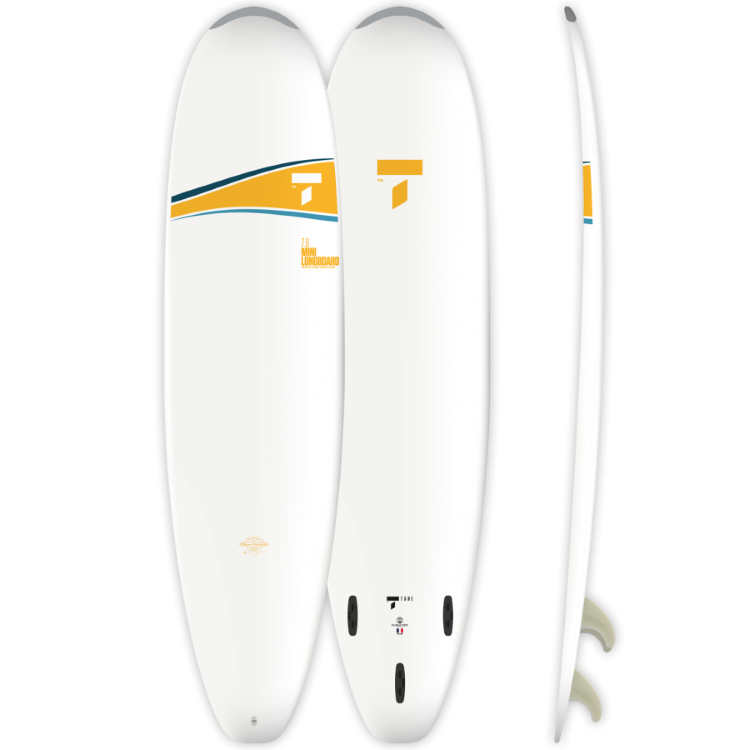
Longboard shape and stability in a smaller more maneuverable frame.
Best for heavier beginners – 8’6” TAHE Paint Easy

Super high volume and ultra-wide with no lack of support and buoyancy. Ideal for larger (200+ lbs) beginner surfers.
Why use a longboard surfboard?
Longboard surfboards are:
- Buoyant, stable, and easy to paddle
- Great for beginner surfers to learn the fundamentals
- Fun for intermediate and advanced surfers
- Great for smaller waves when shortboards are not suitable
- Between $250 to $1000 or more to purchase
- Difficult to duck dive, learn to turtle roll instead
Longboard surfboards are long, high-volume surfboards that promote a relaxed and flowy style of surfing. In addition, beginner surfers should start on a longboard because they are more buoyant and stable, allowing newcomers to learn the fundamentals.
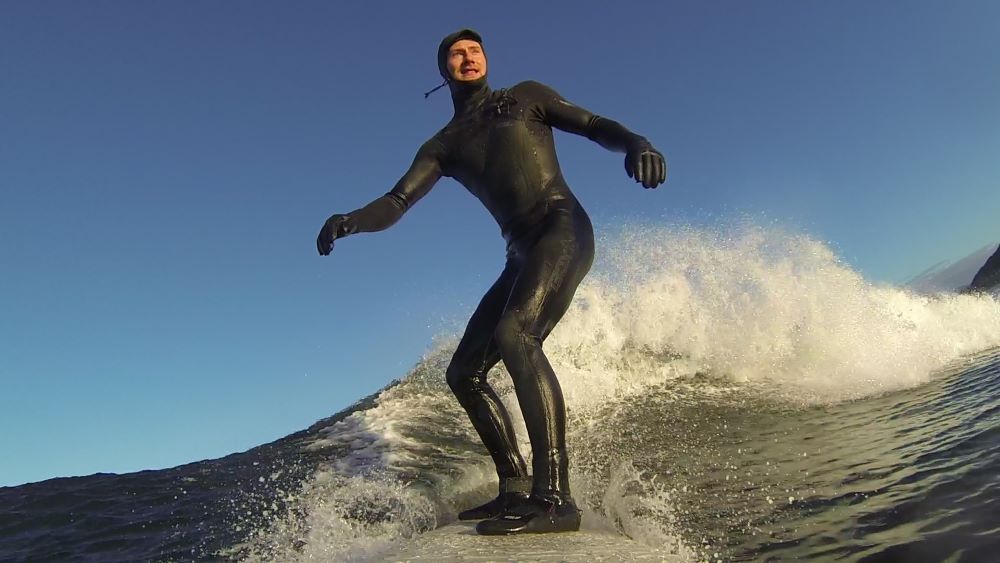
At the same time, many advanced surfers also enjoy longboarding. In fact, there are numerous advanced longboard maneuvers that are fun and challenging. Longboards are great in smaller waves when conditions are not good for shorter boards.
What size longboard surfboard is best?
Choosing a surfboard that is too small is one of the most common mistakes for beginner surfers. It is important to select a surfboard that is appropriate for your skill level and surfing goals. The table below shows the correct longboard length and volume based on your weight and skill level.
| True Beginner (Surfed < 5 times) | Beginner (Surfed > 5 times) | Intermediate to Advanced | ||||
| Weight (lbs) | Length (ft, in) | Volume (liters) | Length (ft, in) | Volume (liters) | Length (ft, in) | Volume (liters) |
| <120 | 7’2” | 72 | 6’8” | 54 | 6’6” | 52 |
| 120 | 7’4” | 74 | 7’0” | 57 | 6’8” | 54 |
| 130 | 7’6” | 76 | 7’2” | 60 | 7’0” | 57 |
| 140 | 7’8” | 78 | 7’4” | 63 | 7’2” | 60 |
| 150 | 8’ | 80 | 7’6” | 66 | 7’4” | 63 |
| 160 | 8’4” | 83 | 7’8” | 70 | 7’6” | 66 |
| 170 | 8′8 | 86 | 8’ | 74 | 7’8” | 70 |
| 180 | 9’ | 89 | 8’4” | 78 | 8’ | 74 |
| 200 | 9’4″ | 92 | 8′8 | 82 | 8’4” | 78 |
| 220 | 9’8″ | 95 | 9’ | 86 | 8′8 | 82 |
| 230 | 10’ | 98 | 9’4″ | 90 | 9’ | 86 |
| 250 | 10′ | 102 | 9’8″ | 94 | 9’4″ | 90 |
| > 250 | 10′ | 105 | 10′ | 98 | 9’8″ | 94 |
Best overall longboard for beginners – 8’ Verve South Beach Board Co.
The 8 Foot Verve by South Beach Board Co. is the perfect soft-top longboard for many beginner surfers. The Verve’s beginner friendly shape and moderate volume is suitable for both learning how to surf and progressing your skills beyond just the basics.
At 8 feet long, 23 inches wide, and 3 inches thick the Verve carries 80 liters of volume within a textured top deck and durable plastic bottom. This size is best suited for true beginners up to 150 pounds and beginners up to 200 pounds.
South Beach Board Co. is a reputable company that primarily makes beginner surfboards among other adventure gear. They sell beginner surfboards ranging from 5 to 9 feet, so shop around if there is a better size for you.
Best budget longboard – Wavestorm
The Wavestorm is a classic longboard in the surfing world. Chances are you’ve heard of the Wavestorm brand. Many surfers begin their aquatic journeys on a Wavestorm.
The Wavestorm is the go-to budget soft-top longboard. You will be hard-pressed to find a new soft-top longboard surfboard for cheaper. There is also a 9-foot version.
I recommend choosing the Wavestorm if you are on a budget or still on the fence about committing to surfing. It is better to decide you are into surfing before investing in expensive gear.
Best longboard for kids learning to surf – 7’6” TAHE Paint Easy
The 7’6” TAHE Paint Easy makes learning to surf, well, easy! With more than enough volume for kids of all ages (110 liters), this surfboard is the ideal option for kids learning how to surf.
It is also super wide (26 inches) which makes it extra stable and forgiving. As a soft-top, kids are less likely to get injured, and the carrying handle makes getting it into the water easier.
For kids who are more advanced, try one of TAHE’s smaller soft-top surfboards. The Paint Easy models are really for true beginners and lack maneuverability.
Best epoxy longboard – 10’ Degree 33 Surfboard
The Degree 33 10-foot longboard is a great epoxy surfboard for beginners looking for a hard-top, intermediate, and advanced surfers. As an epoxy surfboard, it is more durable, lighter, and more buoyant than traditional PU construction, which is great for beginners. Learn more about the difference between epoxy and PU surfboards.
It has sufficient volume (89 liters) for beginners and heavier surfers, but the shape is also conducive to more advanced surfers. Regardless of your skill level, you will have a great time on this board.
Degree 33 is a reputable company that makes different sized longboards, as well as other styles of surfboards.
Best mini longboard – 7’6” TAHE Mini Longboard
The TAHE Mini Longboard has a longboard shape in a smaller frame. At 7 foot 6 inches it is shorter than a longboard but still carries a lot of volume for its length (62 liters). It is quite stable and buoyant making it great for surfers looking for the longboard stability with extra maneuverability.
The epoxy construction is durable and lightweight, which makes transportation easier. You also don’t really need a board bag, as dings are not so much of a worry compared to PU surfboards.
TAHE is a reputable watersports company that makes a variety of surfboards. I personally own two of their hard-top surfboards and love them!
Best longboard for heavier beginners – 8’6” TAHE Paint Easy
For true beginners and larger surfers, volume is the key ingredient, and the 8’6” TAHE Paint Easy is just what you need. Coming in at a whopping 140 liters, this soft-top can support surfers up to 265 pounds.
Lighter surfers who are true beginners will also benefit from the high volume. Catching waves is a breeze with this surfboard. Balancing on them is easier too because it is 27 inches wide.
That said, because it is so wide and thick, the TAHE Paint Easy is best for true beginners and heavier surfers. Maneuverability is not its strong suit, so keep in mind that you may “outgrow” this board as your skills improve and you want to do more turns.
TAHE is a reputable watersports company that also sells a variety of other soft-top surfboards ranging from 5’6” to 8’6”.
Soft-top vs hard-top longboards
Hard-tops and soft-tops (aka foamies) are quite different, and each serve a unique purpose. Soft-top surfboards are best for true beginners and surfers who have trouble managing a surfboard in the waves (such as kids and older folks).
Hard-tops surfboards, on the other hand, are more responsive, and allow for more turns and fun maneuvers. In fact, hard-tops are meant for beginner-intermediate surfers because they require more expertise to manage. Hard-tops can cause more serious injuries during collisions, so be honest with yourself on when you can upgrade to a hard-top.
| Hard-tops | Soft-tops | |
| Pros | Better performance (maneuverability) | Super durable Lower risk of injury from collision Usually more affordable No wax needed |
| Cons | May not be as durable Higher risk of injury from collision Usually more expensive | Worse performance (maneuverability) |
| Conclusion | Best for beginners who have the basics down and want to progress to the next level | Best for true beginner surfers who are learning the basics. Good for kids or older people who may have more trouble managing a board |
Which longboard is best for you?
When choosing the right longboard for you, consider the size, material, and shape that is best for your skill level, local waves, and surfing goals. There is a lot to consider when buying a surfboard in general. If you’re new to surfing, check out my full guide to buying a surfboard for beginners.
In brief, if you are a beginner, don’t fret over the technicalities when shopping for a longboard. Get something affordable and functional. If you are a true beginner, I recommend buying a soft-top surfboard.
If you are a beginner looking to progress your surfing to the next level, you should consider buying a hard-top surfboard, but not before you know you are ready to upgrade to a hard-top surfboard.
If you are intermediate or advanced, you may want to think more about technicalities like if you want a high-performance or a nose rider longboard, the fin setup, or the rail type.
High-performance vs nose rider longboard?
In the world of longboard surfboards, there are two general longboard shapes: high-performance and nose rider. These two shapes are made for different maneuvers. High-performance longboards are better for faster turns and steeper waves. Nose-rider surfboards are better for stepping and nose riding (think hanging-ten).
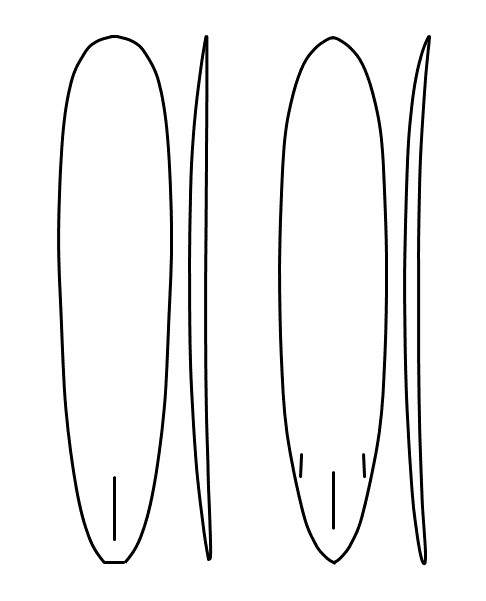
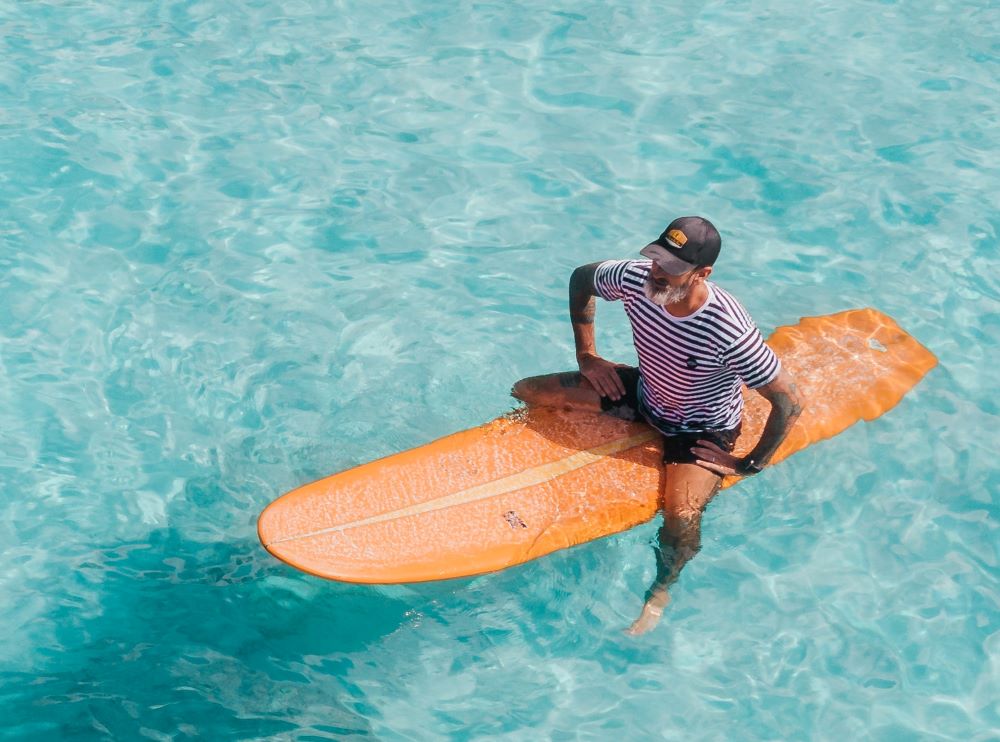
Nose rider longboards are wider throughout the nose and tail for stability and offsetting weight when the surfer is on the nose.
High-performance longboards are narrower, allowing surfers to make faster turns. They also have a more pronounced rocker which helps on steeper, fast-moving waves. Furthermore, the three-fin setup provides extra grab and control.
Longboard fins
Longboard surfboards almost always have either a single fin or a thruster setup (three fins). In short, single fins equate to higher speed (less drag) while a thruster setup provides more control during turns.
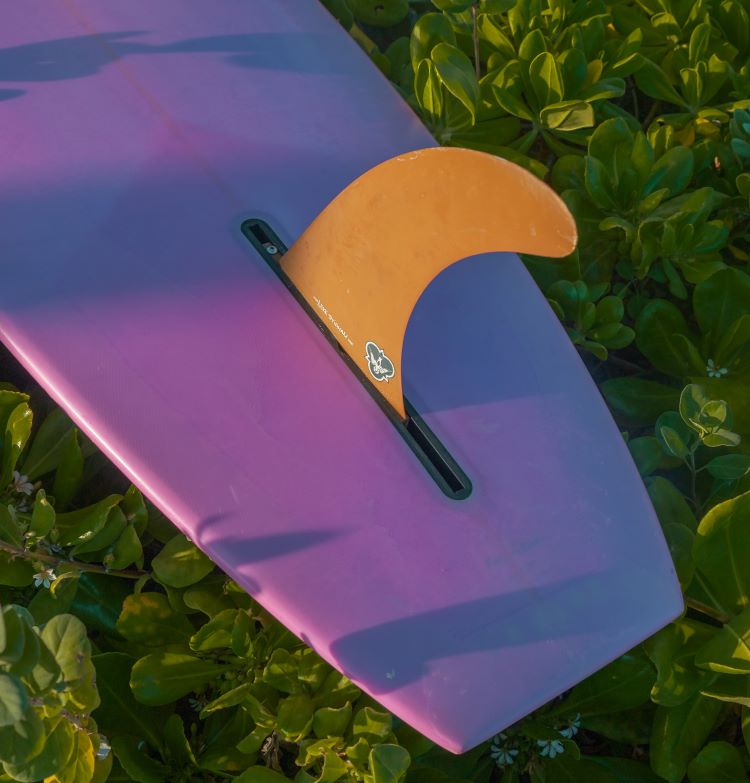
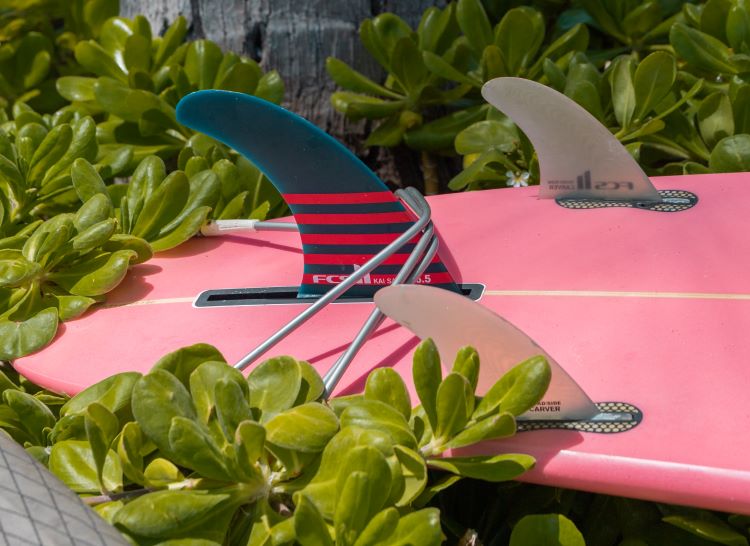
In general, choose a single fin setup when you want higher speed on smaller, mushy waves. During larger and steeper waves, a thruster setup will help tighten up your turns and provide more control.
Longboard rail type
Surfboard rails fall somewhere on the spectrum of “hard” or “soft”. Soft rails are more rounded throughout the entire curve of the rail. Hard rails are sharper on the bottom have of the curve.

Soft rails make the surfboard more buoyant and stable (better for beginners). Hard rails make the surfboard more responsive and have more control (better for performance and maneuvers).
Downsides of longboard surfboards?
Longboards have a lot of advantages, but also fall behind compared to other styles of surfboards in some cases. Specifically, longboards struggle in larger waves (6+ feet) because they are too big to duck dive and generally hard to manage, not to mention dangerous, in larger surf.
Longboards also struggle in fast, steep, and hollow waves. In addition, duck diving is impossible with a longboard. The turtle roll is an alternative, but it is still overall harder to paddle out to the break using a longboard in certain conditions.
Furthermore, longboards are bulky and hard to transport. A roof rack or other well thought through setup is necessary. You can’t really through your longboard in the back of the car like a shortboard.
How much do longboard surfboards cost?
Longboard surfboards cost between $250 and $1000 but can cost even more. Soft-top longboards cost around $250 to $600. PU and epoxy surfboards are typically more expensive and range from $450 to $1000.
Buying a used surfboard is a great way to save money and avoid the high costs of a new surfboard. Used surfboards can be heavily discounted when compared to retail price. Learn more about how to buy a used surfboard.
Do you need a surfboard bag for a longboard?
It depends on the type of longboard you own. If you own a soft-top, you do not need a surfboard bag because soft-tops are already so durable. If your surfboard is PU (poly), you should invest in a board-bag to protect the fragile polyester resin from dings.
Epoxy surfboards are more durable than PU boards, and a board-bag is not quite as important, but it doesn’t hurt to have the added protection.
If you decide to purchase a board-bag to protect your longboard, make sure it is the right size. Get something like the Ocean Broad Longboard Bag, which comes in various sizes, to prevent unnecessary dings to your PU or epoxy longboard.
Should you buy a longboard online or in-store?
Consider if buying a longboard online or in-store is better for you. I have a whole article about buying a surfboard online or in-person.
Buying a surfboard online is better if you:
- Want the most options
- Don’t need the board right away
- Understand the risks and costs of shipping (read their return policy!)
- Don’t want to drive to the surf shop
Buying a surfboard in person is best if you
- Want to see and feel the board in person
- Want to take your board home that day
- Want to pick up other surf gear
- Want advice from a real person face-to-face
Heads up! Surfing is awesome but it can be dangerous! Learn more about how to stay safe and avoid dangers while surfing. If you are a beginner surfer, check out my other articles about surfing and my ultimate guide to learning how to surf.

![Best longboard surfboards [2023] – all skill levels surfer with surf hat](https://mindfulladventure.com/wp-content/uploads/2022/10/surf-hat-crop-1000-770x515.jpeg)







